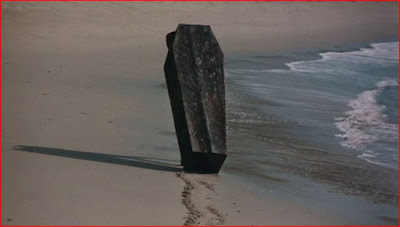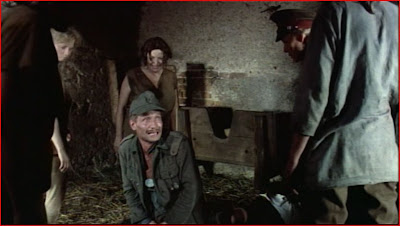 "Deathmaster" is an epithet originally applied to Count Yorga, the bachelor pad vampire played by Robert Quarry in two popular films at the start of the 1970s; the term is used in the ballyhoo for both movies. So it was a natural next step by the logic of exploitation to put Quarry into another vampire movie with Deathmaster as the title. The logic occurred to Quarry himself, who was an associate producer of this film. And of course, the same exploitation logic dictates that if you put Quarry in a vampire film called Deathmaster, then it cannot be about Count Yorga.
"Deathmaster" is an epithet originally applied to Count Yorga, the bachelor pad vampire played by Robert Quarry in two popular films at the start of the 1970s; the term is used in the ballyhoo for both movies. So it was a natural next step by the logic of exploitation to put Quarry into another vampire movie with Deathmaster as the title. The logic occurred to Quarry himself, who was an associate producer of this film. And of course, the same exploitation logic dictates that if you put Quarry in a vampire film called Deathmaster, then it cannot be about Count Yorga.Instead, Quarry and company, under the direction of Ray Danton, intensify the contemporary relevance that made the Yorga films stand out from the horror crowd. Deathmaster taps into post-Manson anxieties about youth culture and cults, making its vampire a more symbolic and thus (hopefully) scarier figure than Yorga was. But the production's striving for relevance ends up making Deathmaster a more dated film than the Yorgas, and a dull ear for youthful speech doesn't help matters. At the same time, that datedness gives the film a document-of-its-time quality that keeps it an item of interest for pop-culture historians as well as horror fans.
Quarry gets real star treatment here, probably for the only time in his career, his entrance delayed as much as possible and his voice heard in advance of his visage to build anticipation for the big reveal. At first, all we see is a coffin washing ashore on a California beach, as if summoned by some tall dude playing a flute. A surfer discovers the coffin on shore and decides to take a peek. Before he can end the film at its beginning, the flautist throttles him, hauls the coffin up on his shoulders and drags it away.
After the credits, we're introduced to factions of hippies and bikers, with one couple standing out in each group. Our head hippies are Pico and Rona, while the principle biker is Monk and Esslin is his consort. Monk is a thuggish lout and the nearest thing to a cynic in this generation, while Pico is a poor man's Billy Jack of a sort -- and Billy Jack was not a rich man. When Monk hassles a craft dealer played by a pseudo-hip John Fiedler (perhaps the least Angry Man of the famous Twelve), Pico puts him down with an unexpected display of martial arts. When he later explains that he was using kung fu, Monk asks if he's Chinese.
Both couples end up at a mansion which someone may be house-sitting, or else they may all be squatting. It's a typical hippie gathering. Some rube is playing a folk song (arranged by Ray Conniff) on his guitar, and some chick is painting in the nude. "Who's the chick?" Monk asks. "Wow..." an admiring hippie answers, "I don't know."
Monk stumbles outside to take a leak and slips a ways down the hillside. When he lands, he finds an empty coffin. Closing it, he finds the tall man poised to strike. Fortunately, Monk resumes slipping downhill and escapes harm for the moment, while the tall man joins another gentleman who appears to control the weather by displaying a ring. Lightning puts out the electricity and the hippies resort to candles. The storm is a downer. One fellow who looks more like a hick than a hippie asks, "Hey, what's happening? We're all hung up on some sort of gloom."
"We're hung up, all right," Pico confirms, "but always the same old thing. Looking for our damn head."
"His head, his head," Rona sings, "Pico can't find his head!"
If you don't find Rona's wit charming, I'm afraid I can't help you. She was introduced earlier informing Pico that it was already snowing at the end of summer. Pico saw no snow, but his girl explained that it was snowing potato chips, dumping a bagful on his head. With such company it's a wonder that someone would complain that life is "a goddamn mother loving bore," but Pico agrees. "That's my whole point, we ain't living!" he says. Do you sense a moral here?
During the discussion a silhouette has snuck into the room to listen and observe. Still shadowed, he starts offering opinions of his own. Then, with a flourish, he claps his hands and the lights come on, revealing Robert Quarry in all his vaguely Christlike, less vaguely Mansonian splendor.
His name is Khorda and his tall friend, whom some of the hippies know, is Barbado. Khorda gets right into the guru business, hectoring the hippies about their eating habits and hygiene. Contemplating their admittedly questionable meal, he asserts that "Such food defiles the blood, destroys that which is beyond price. You feast on filth in your house, yet you speak of life, love." And their house is filthy, too. They ought to clean it up and "Eat living food. Then you will come alive. Then you will be deserving of your purpose." But he clams up when Monk scoffs, and despite being urged to stay (Pico: "We groove on what you're saying.") he shuffles off and dematerializes in front of everybody. "Wow," someone comments, "that cat is something else!"
You can't deny that Khorda has a positive effect on the hippies. They actually do clean the house and commence buying organic food -- you know, no meat, animals presumably being made out of plastic. They are a tireless audience for Khorda's nattering advice, always excepting Monk, who annoys Khorda with his dangling Iron Cross. The guru orders him to conceal it, apparently having strong feelings about Prussian militarism, but Monk says it goes where he goes, which is outside in a huff.
As Monk goes off for a bike ride, Khorda starts making the moves on Esslin. In the bedroom, he dares her to notice something missing when she looks at them in the mirror. I like his aggressive, pre-emptive approach to the familiar problem mirrors pose for his kind.
Khorda: The glass reflects only what you expect to be, not what you can become. It cannot reflect the essence of the spirit, that ultimate sanctification that can never be seen by the human eye. It can only be experienced! Felt! Its power defies the mirror. Look, look!
When you think about it, Khorda's just being mean. Why such a line of buncombe when he's only going to bite her neck with his mouth full of fangs? The man must like the sound of his own voice, and if he's Robert Quarry, who can blame him? The actor's smooth delivery made him an ideal Seventies vampire and he really gets to work the voice on some rants in this show.
He also shows off his versatility with a leap attack to finally rid himself of the obnoxious Monk. The funny thing about this attack is that we'll later learn that the big tough biker died of shock. The rest of the kids are distracted from the sounds of mayhem by the sight of Esslin dancing to Barbado on the bongos. Soon, everyone but Pico and Rona gets into the rhythm and it ends up looking like the rehearsal dance from A Charlie Brown Christmas on pot in the house as everyone does his own thing to a really slow beat.
While our two lead kids seem immune from Khorda's charms, the rest of the cast succumb in short order and offscreen, the women acquiring appropriate slinky vampire-bride garb and one man sporting quite the sporty turban. They're all appetizers, however, as Khorda really covets Rona. He captures her, but Pico escapes through a network of tunnels to reach Pop, the elderly wannabe-hippie who finds himself pressed into the Van Helsing role for this picture.
Getting no cooperation from the cops, our vampire hunters invade the house in time to find Rona being prepared for a blood sacrifice that will keep Khorda going and make the rest of the gang immortal. As Khorda explains:
We do not seek to sustain ourselves on empty religious conceits. We abstain from them, in order that we may hold solely and always to the ever-enduring continuity of human life itself. We open our hearts to the unholy. We seize life, cherish it, maintain it forevermore. It is a mission of existence. To the huddled fools of this world God is but a word by which they would excuse all manner of vile behavior. We alone shall inherit existence, shall know foreverness. The hour is now, now.
So stunned are Pop and Pico by this oration that they stand stupefied as Khorda applies the fangs to Rona and catches her blood in a goblet. Weren't they there to stop that? Don't worry just yet, though. In their research (I think Pop had a paperback copy of The Book of the Vampires) they learned that there's always an incubation period after a bite, so Rona might yet be saved....
But this is a Seventies horror film, so I trust I don't spoil too much by saying don't bet on it. Indeed, Deathmaster has one of the most downbeat endings of a decade of downers. Not your normal evil-wins shock ending where the girl gets all fangy at the end and pounces on the hero, but one that expresses utter futility and hopelessness, which is only proper, since Bill Ewing proves a futile, hopeless actor. Actors and writers alike appear to have taken the Hippie Lingo as a Second Language course, their grades ensuring that this was the best work they could get, though Ewing would go on to re-emerge as the writer-producer of End of the Spear. Quarry is pretty much speaking his own language here, with dialogue to make Dudley Manlove's mouth water, but delivered with Criswellian authority. But as a whole it works, or at least he works in the part, even if he is somewhat too old to embody a Manson archetype, however supernaturalized. Nor is Quarry to blame for questionable aspects of the script, such as Khorda's habit of keeping a fishbowl full of leeches in his crypt (for what? finger food?), only to have them thrown into his face to debilitating effect by Pico at a desperate moment in the story.
Quarry is not well supported by the cast and crew of Deathmaster, but together they do manage to catch a fragment of an anxious zeitgeist. Although it was certainly designed for the drive-in and grindhouse crowd, it comes across as a film more about youth than for them. Understood that way, Deathmaster can still be appreciated for what it tries to express and, to a limited extent, succeeds in expressing.
NOOOOO!!!!!
The trailer for Deathmaster was uploaded to YouTube by DIOTD2008




























































